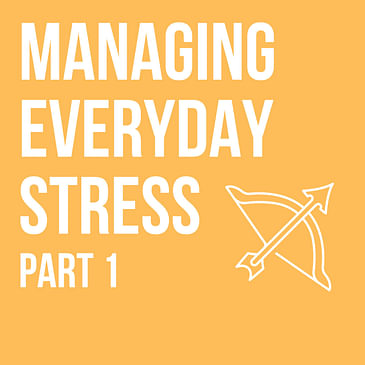Shownotes
Episode Premise
Disappointing situations are a common occurrence in life. If we are passed over for a promotion, have a heated argument with our spouse, feel let down by a friend, or face any negative event in this realm - it's common to exaggerate and dramatize the situation in our minds, making the issue exponentially worse.
This causes stress and anxiety. It affects our mental health.
Why does this happen and how do we deal with this? That's the focus of this episode.
Second Arrow Syndrome
There’s an ancient Buddhist parable that provides a visual framework to understand this behavior - the second arrow syndrome. The first arrow is the negative event that happens to us, which is typically external and often we do not have any control over this. This is accompanied by a second arrow - the pain we inflict upon ourselves. It’s the layer on top - stories, drama, that we create. It’s the more lethal arrow that makes the problem exponentially bigger. The good news is that this arrow is created by us and can be controlled by us
Why do we create this drama in our minds?
Our brains are wired in such a way that when we feel attacked the emotional part of our brain takes over. In this emotional state when we try to understand all thoughts, however logical, get contorted into negative drama. In this charged state - these thoughts/solutions/analysis is the fuel that converts a spark into a fire. In modern-day living, we have multiple problems. All these at 10 times their size sit in our head causing stress and anxiety.
Two ways to process stress and anxiety
There are multiple ways. In my opinion, these sit in two buckets. One is via emotions and feelings and the other through the intellect. In this episode, we deal with problems via emotions/feelings using a mindfulness technique.
Mindfulness - Brief Summary
- It’s derived from Buddhism but has no religious connotations. It’s secular.
- Simply put - Mindfulness means - means bringing attention to the present moment.
- Although this is an ancient art, there is a vast array of empirical evidence to show how powerful this technique is.
- It’s proven to help with depression, stress, anxiety, addiction among others.
- Brains of folks practicing mindfulness have been studied - before and after via fMRI scans. After mindfulness - they are seen to be calmer, less reactive.
For additional information, we’ve recommended 3 books (under resources) that are a good starting point to understand mindfulness.
How does mindfulness work in this context?
The role of mindfulness is to move us from the emotionally charged state to a calm/relaxed/peaceful state. In this state, all our faculties - creative, intellectual - are available to us. Using these we can read the situation we are in and find the best way forward. Most mindfulness techniques work with a 2 step process
1. Acknowledging the pain or hurt that a negative event has caused.
Often many of us do not do this as we may think we are brave and something like this does not affect us. As a result, the emotion comes out elsewhere maybe in losing our cool with a spouse or not sleeping well, or being edgy at work.
2. Giving attention to the emotion
This is counter-intuitive. Instead of stepping away from the negative emotion- we step into it. We sit with it. We give it attention. Paradoxically, focusing on the pain helps heal the emotional wound.
Mindfulness Technique - Noting
Typically noting is part of meditation practice. However, we feel this technique can even be extremely useful for folks who do not meditate. It can be done at home or during a commute using the following steps -
- Close your eyes
- Take 3-4 deep breaths.
- Think of a setback that you faced recently.
- Replay it in your mind
- Notice if any emotions arise
- Now simply note or label each emotion that emerges
- If you see anger - say there is anger
- We do not say - I am angry.
- Anger is a separate entity.
- We look at anger and then let it go
- We scan to see if there is any other emotion
- We do the same.
- Like this, we simply sit and note whatever emotion comes up
It’s important to note that we are only dealing with feelings and emotions here. We should not pay attention to any intellectual thought, judgments, logic etc. These will come. And the way to deal with them is - we note them as well and move back to emotions. A good trick to ensure that the mind does not get caught up in thoughts is to become curious.
After doing this exercise for a while, we start to become calmer and more peaceful. Doing this a few times can help us reduce the intensity of a wound.
For more information on noting, here is a good article. As you will see this is typically a part of meditation -
https://www.insightmeditationcenter.org/books-articles/mental-noting/
Welcoming emotions to one’s house
The great Sufi poet Rumi would think of his body as a guest house and would welcome all guests - invited or uninvited.
I’ve experimented with having coffee with these guests. It reduces the intensity of emotions and makes them manageable.
Do try your own version of this.
The link to Rumi’s poem -
https://www.scottishpoetrylibrary.org.uk/poem/guest-house/
The mindfulness interpretation of the poem -
https://www.mindfulnessassociation.net/words-of-wonder/the-guest-house-rumi/
Resources
Some good starting points for mindfulness -
Wherever you go, there you are - Jon Kabat-Zinn
